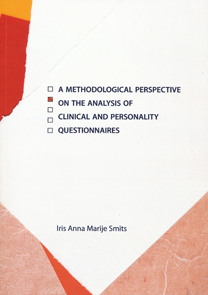 University of Groningen
University of Groningen
Faculty of Behavioural and Social Sciences
Heijmans Institute
Supervisors:
– prof. dr R.R. Meijer (University of Groningen)
– dr M.E. Timmerman (University of Groningen)
On 20 February 2014 Iris Smits defended her thesis entitled
A methodological perspective on the analysis of clinical and personality questionnaires
 Summary
Summary
Psychologists regularly use clinical and personality (C&P) questionnaires for the assessment of particular personality traits and / or psychopathological symptoms. To assess the quality of C&P questionnaires, specific measurement models are of interest. This thesis discusses the characteristics and usefulness of these measurement models for the analysis of C&P questionnaires.
Mokken scale analysis (Mokken, 1971) can be used to identify items that together form a Mokken scale. These Mokken scales are regularly interpreted as reflecting unidimensional scales, i.e., scales that measure a single trait. In this thesis, it is shown that this interpretation is not necessarily correct, because one Mokken scale can measure multiple traits and multiple Mokken scales can measure a single trait.
For the skew-normal factor model and the quadratic factor model, it was not clear which model is useful in which conditions. In this thesis, it is illustrated that observed data that follow any skew-normal factor model can be so well approximated with a quadratic factor model that the models are indistinguishable in practice. The reverse does not necessarily hold. Consequently, for the analysis across populations, the skew-normal factor model is preferred over the quadratic factor model.
This thesis also gives some examples of applications of measurement models for C&P questionnaires. Discussed are the use of the bifactor model for the evaluation of the specific contribution of subscale scores above the total scale score of the SCL-90 and measurement invariance tests (i.e., whether a questionnaire measures equally across populations) for the SDQ and Big Five personality factors.
Project
The incremental value of Item Response Theory to personality assessment
Psychological assessment is one of psychology’s major contributions to everyday life. An important part of psychological assessment is personality assessment which is a professional activity of numerous research, clinical, and industrial psychologists.
In personality assessment often self-report inventories or scales are used. Scale construction and revision within the field of personality measurement relies heavily on classical test theory (CTT) and factor analytic methods. Though CTT methods of scale development and scoring have served personality measurement reasonably well over the last 80 years, CTT has serious limitations and shortcomings (see, for instance, Fischer, 1974). These limitations and shortcomings are related to the fact that CTT is a model for the test performance of a randomly drawn respondent from some well-defined population where the influence of the ability level of the respondent and the influence of the difficulty of tests or items on the test score are not separated. In item response theory (IRT, for an overview, see van der Linden & Hambleton, 1997), on the other hand, the influence of respondents and test items are explicitly modeled by different sets of parameters. This model property proved essential for such activities as linking and equating measurements and evaluation of test bias and differential item functioning. Further, it provided the underpinnings for item banking, optimal test construction, and various flexible test administration designs, such as multiple matrix sampling, flexi-level testing, and computerized adaptive testing. Therefore, in the last decades IRT modeling has rapidly become the theoretical basis for educational assessment and assessment of cognitive ability.
In psychology, the development of personality and attitude questionnaires through IRT is almost nonexisting although these models are becoming more popular (e.g., Reise & Waller, 2009; Egberink & Meijer, in press; Meijer, Egberink, Emons, & Sijtsma, 2008). This is unfortunate because the requirements with respect to the objectivity, reliability and validity of psychological assessment are increasing.
In this project, we explore the incremental value of IRT to the assessment of personality and psychopathology.
This project was financed by the University of Groningen (RuG)
